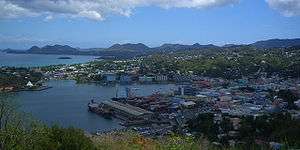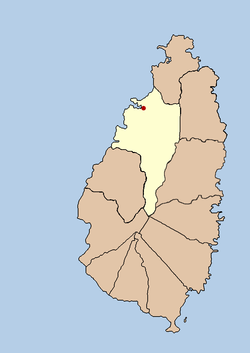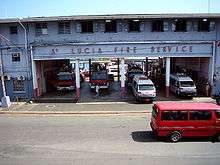Castries
| Castries | |
|---|---|
| City | |
 Castries | |
| Motto(s): Statio Haud Malefida Carinis ("A Safe Harbour for Ships")[1] | |
 The Quarter of Castries, showing Castries city (red dot) | |
| Coordinates: 14°01′N 60°59′W / 14.017°N 60.983°WCoordinates: 14°01′N 60°59′W / 14.017°N 60.983°W | |
| Country |
|
| Quarter | Castries Quarter |
| Founded | 1650 as "Carenage" |
| Renamed | 1756 as "Castries" |
| Founded by | the French |
| Named for | Charles Eugène Gabriel de La Croix, marquis de Castries |
| Government | |
| • Governing body | Castries City Council |
| Area | |
| • Total | 79 km2 (30.5 sq mi) |
| Elevation[2] | 2 m (6.56 ft) |
| Population (2013) | |
| • Total | 70,000 |
| • Density | 890/km2 (2,300/sq mi) |
| Time zone | UTC-4 (Eastern Caribbean Time Zone (ECT)) |
| Area code(s) | 758 |
| HDI (2006) | 0.814 – high |
Castries /ˈkæstriːz/ (![]()
Castries is in a flood gut and is built on reclaimed land. It houses the seat of government and the head offices of many of foreign and local businesses. The city's design is in a grid pattern. Its sheltered harbour receives cargo vessels, ferry boats, and cruise ships. It houses duty-free shopping facilities such as Point Seraphine and La Place Carenage. Many restaurants offer menus from local to Chinese. Supermarkets and other shopping facilities provide goods. The city is well served by a bus system and taxi service.
St Lucia's main post office is in Castries. Because most parts of the country do not use standard street addresses, mail is largely sent to P.O. boxes. Any mail sent without a town name ends up in the Castries post office.
Castries is the birthplace of Arthur Lewis, winner of the 1979 Nobel Memorial Prize in Economics, as well as of Derek Walcott, winner of the 1992 Nobel Prize for Literature.
History
In 1650, the fort aupres du Petit Cul-de-Sac et de la riviere du Carénage was founded by a group of 40 Frenchmen led by de Rousselan, when St. Lucia was purchased by Capt. du Parquet and Monsieur Houel from the French West India Company. The capital was moved to the south side of the harbor in 1769 by Gov. Baron de Micoud. In 1785, the village of Carénage was renamed Castries, after Charles Eugène Gabriel de La Croix, marquis de Castries, the French Minister of the Navy and Colonies.[3]
In 1835, the British built the western wharf in preparation for the coaling trade and the first steamship arrived in 1841, the RMS Solway.[3]:163,243–244
During World War II on 9 March 1942, the German U-161 sailed into Castries harbor at night and sank two allied ships,[3]:275[4] including the Canadian ocean liner RMS Lady Nelson, which was subsequently refloated in the harbour and taken to Canada to be converted to a hospital ship.
Castries has been rebuilt many times, following major fires on 15 Oct. 1805, 6 April 1813, and most notably on 19 June 1948.[3]:124–125,289
Tourism
One of the major tourist areas in St. Lucia, Castries is a port of call for cruise ships. They dock at Pointe Seraphine, to the north of the harbour.
Castries has landmarks, such as the Cathedral of the Immaculate Conception, Derek Walcott Square (renamed from Columbus Square to honor the island's Nobel Prize-winning poet, Derek Walcott), the City Library, the Government House, and Fort Charlotte, at the top of Morne Fortune (an 845-foot or 258 m hill). Beaches include Vigie Beach, Malabar Beach, Choc Beach, and La Toc Beach..
Transport

Castries is served by George F. L. Charles Airport, also known as Vigie Airport. Passengers on longer flights arrive at Hewanorra International Airport, near Vieux-Fort. The drive between Hewanorra and Castries can take an hour and a half. Helicopter service between the airports shortens travel time.
Ferries run between Castries and Fort-de-France, Martinique. Yachts may dock in Castries, though they must clear customs first. When the customs area is full, yachts must anchor at the quarantine dock to wait; those that do not are fined. Afterward, yachts may anchor in front of Castries Town or Vigie Creek.
Standard bus routes run from Castries to all outlying districts on the island. The buses are private (not subsidized by government) bearing green license plates with numbers that start with an M—for example, M456. The buses line up in designated areas to pick up passengers. The bus fronts displays a route band, a luminescent sign that indicates which part of the island the bus is traveling to. To get to other areas, one can use the buses or the taxi service, which have blue license plates. Private minivan buses offer transportation from bus stops and can be flagged down on the roadside. Buses are the most affordable, local way of getting around st Lucia and great way to experience island life, although many attractions and parts of the island are not serviced by public transportation. Privately owned and operated 14–seater minivans with green “M” license plates run individual routes between major communities. There is no schedule, simply wave them down along the main road and pay when you get off, unless the driver collects the fare before leaving. Within larger communities, there are specific bus stops, and buses will not depart until they are full. You may have to wait up to 30 minutes, and in most places public transportation stops after 6 pm.
Political institutions
As well as being the capital city of Saint Lucia, Castries hosts the secretariat of the Organisation of Eastern Caribbean States. Castries also hosts the headquarters of the Eastern Caribbean Supreme Court.
In October 2008, the American Chamber of Commerce, Saint Lucia, was established. The establishment of a chamber was encouraged by the U.S. Embassy, Barbados. Hugh W. Jones was elected and installed as its first president.
A number of international embassies and consulates keep their headquarters in Castries. They include the Organization of American States, British High Commission, Mexican Embassy, embassy of the Republic of China (Taiwan) (in Rodney Bay), Dominican Republic Consulate, French Embassy, Italian Vice Consulate, Jamaican Consulate, Netherlands Consulate, Norwegian Consulate, Brazilian Embassy and Venezuelan Embassy.


See also
References
- ↑ "Archived copy". Archived from the original on 2009-09-28. Retrieved 2009-07-29.
- ↑ "Weather in Castries. Current weather | lc.freemeteo.com". Freemeteo.com. Retrieved 2016-08-10.
- 1 2 3 4 Harmsen, Jolien; Ellis, Guy; Devaux, Robert (2014). A History of St Lucia. Vieux Fort: Lighthouse Road. p. 23,43–44,52,163. ISBN 9789769534001.
- ↑ Hubbard, Vincent (2002). A History of St. Kitts. Macmillan Caribbean. p. 117. ISBN 9780333747605.
External links
| Wikivoyage has a travel guide for Castries. |
| Wikimedia Commons has media related to Castries. |
- Official website
- Interactive tour of St. Lucia's History and Culture: Official site for St. Lucia Tourist Board
- Worldaware Lesson plan on Castries: site owned by SOS Charity UK